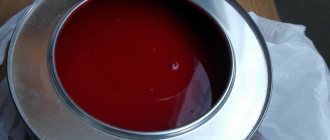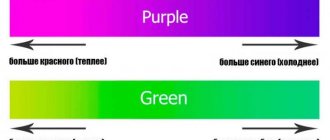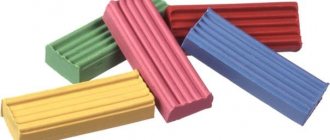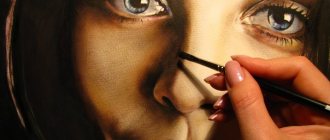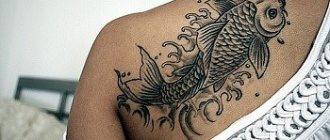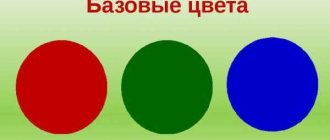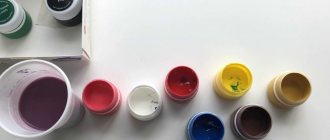» How to get color » How to get orange color by mixing paints
How to get orange color and its shades in 10 photos + table of all possible derivatives. How to get coral, peach, terracotta and red colors? The influence of white, black and brown in color composition. Orange color is obtained by mixing red and yellow, but you can get a shade of this color (soft and quite light) by adding pink to yellow paint. Subsequently, all the main saturated shades of orange are in one way or another connected with red, yellow, pink, and white. More complex and darker tones are obtained using purple, brown and black.
How to get orange color by mixing paints: red and yellow of the desired tone?
Everyone knows that the main gradient of orange lies within red-orange and yellow-orange. Since the color is obtained from two colors, depending on the percentage of each color there is a shift in one direction or another. Of course, all the resulting shades from the primary colors (in our case, red and yellow) will be paler. However, orange consists of 2 warm tones, the waves of which are not very different (the opposite would be blue and yellow to create green), and even in the second order it looks quite catchy.
Mixing acrylic paints for painting:
Red
The red palette has a wide variety - from soft pink to dark purple.
Read also: Balneotherapy and what it is
You can play with shades of red by adding white to the main paint.
Regular purple tone
It is obtained by adding a couple of drops of bright blue and bright yellow to the red paint;
How to get yellow-orange and red-orange?
It is believed that to get classic orange, you need to take 1 part yellow and 1 part red. However, in practice it turns out that you have to take more yellow than red. In the palette you can always choose the desired tone by adding yellow or red to the mixture.
How to get light orange color?
This tone comes in a wide range of pastel shades. They are built using white, but there is an alternative option: we mix pink and yellow, the resulting shade is a soft orange tone, belonging to the light range:
Another option would be to add yellow and white. Usually in a palette of 12 colors there is already an orange tint, which is much brighter than the color obtained by mixing, so when constructing shades we will use the already existing one. In my palette of glossy acrylic paints there is a bright red-orange tone. To get light orange tones from it, I will need to mix red-orange, yellow and white:
Mixing paints
After all preparations are completed, you can begin to work.
The resulting shade will depend on the proportion of components mixed and the sequence of layers.
If the first layer is yellow and red is applied on top, then the tone will be lighter, and if vice versa, then darker.
On paper or wall
You can mix directly on the work surface. In this case, the layer-by-layer method is used. After applying the first layer, you need to wait until the paint is completely dry and only then apply the next one, but this method is not suitable for all techniques.
On the palette
You can get the desired shade using a special or homemade palette - this way, in case of failure, it will be easier to correct the mistake. This mixing method is mechanical; the resulting color is applied to the canvas in one layer at once.
Mechanical mixing is used when working with textured paints, because it is more convenient to create a relief surface.
Mixing colors on a palette to obtain the desired shade.
How to get coral color?
Although this shade is closer to pink, its construction is completely tied to the orange color, and there are 2 scenarios for obtaining it: 1) Complex: take red-orange, pink and white in approximately equal parts (when you mix, adjust the shade by eye, the main thing is mix the paint thoroughly).
2) Red-orange is close to scarlet, and scarlet is a shade of red. Red, when mixed with white, produces pink, and coral can be called a light shade of pink with an orange undertone.
In this case, coral will lean closer to orange, but still remain a luxurious tropical shade.
Every pastry chef is an artist who strives to ensure that his creation becomes a real work of art. Only an artist uses paints, and a confectioner uses food colorings, which, unfortunately, are not healthy. But how to get out of this situation, because not only taste is important for dessert, but also appearance?
Let's find out!
To give your confectionery a beautiful color, you don’t have to run to the store and buy all kinds of synthetic food dyes. It is enough to have a few vegetables and fruits on hand with which you can make natural food colors at home. The only thing is that the colors obtained this way will not be very bright and saturated.
So, how can you make food coloring at home and get the color you want?
Natural food coloring: red and pink
The best ingredient for getting a natural pink color is beets. Its juice will change the color of the product without affecting the taste.
How to do it?
Simply wash the beets and place them in a blender with 1/2 cup of water. Mix everything until smooth, then strain. The resulting liquid is your natural food coloring.
You can also use cherry, pomegranate and raspberry juice to make red dye.
Natural food coloring: orange
To make orange food coloring, the ingredients needed are papaya, mango or pumpkin. But the easiest way to get orange is to use carrots.
How to do it?
Peel the carrots, grate them on a coarse grater and place them in a hot frying pan. Pour in butter and fry over low heat. Then let the carrots cool and strain through cheesecloth. You can also use carrot juice as a dye.
Natural food coloring: yellow
If you've ever used turmeric, then you know that it turns yellow everything it touches: clothes, skin, tables, etc. Therefore, be careful when making this dye.
How to do it?
Mix 1/2 cup water and 1 teaspoon ground turmeric in a saucepan and then boil. Let cool. This dye should be stored for no more than two weeks in the refrigerator.
Natural food coloring: green
The combination of Matcha green tea powder and spinach creates a beautiful green color that is perfect for garnishing dishes.
How to do it?
Combine 1 tablespoon Matcha powder, 1/2 cup fresh spinach and 1/2 cup water in a blender. Mix until smooth, then strain. The resulting liquid is natural green food coloring.
Natural food coloring: blue and purple
The most difficult color is blue. It can be obtained from eggplant peels, grape juice, blue potatoes or purple/red cabbage. Blueberries also make a great natural purple food coloring.
How to do it?
Combine 1/4 cup fresh blueberries with 1/8 cup water in a blender. Mix until smooth, then strain to obtain natural purple food coloring.
To get blue natural dye from purple/red cabbage you need to boil it, after which the water will turn dark. You can use this water as a dye, and to make the color brighter, add a little soda.
Natural food coloring: brown
The brown color can be obtained not only from cocoa powder, coffee or chocolate, but also from burnt sugar.
How to do it?
Mix sugar with water 5:1 and pour into a frying pan. You need to fry the sugar over low heat, stirring constantly. When the mixture reaches the desired shade, remove it from the heat and add a little more water.
Natural food coloring: black
An important role is also played by the black dye, which can be obtained thanks to a special type of cocoa powder called “Dutch ultra”. Also, to get black food coloring, you can use cuttlefish ink, but the dishes will then have a salty taste.
You can also mix food coloring to create different shades and new colors.
We hope that the article on natural food colors was useful to you. Don't forget to "like" it.
Table for obtaining orange shades when mixing colors:
Practice in color science is irreplaceable, but theory can give you an understanding of how this or that tone is built.
In the center is the main color from which the color is built. The first circle of colors is the shades with which the color is mixed in the proportion indicated below. The third circle is formed by tones that were obtained by mixing the main color and the first circle in a smaller proportion than the third. On the sides of the color at the end of the beam, the same color with the addition of black (darker) and white (lighter).
How to get other colors and their shades: theory and practice. Click on the icon.
How to make brown food coloring
If you need brown food coloring for confectionery, the easiest way to make it is from cocoa or burnt sugar, but if you are preparing salty dishes, you can achieve the brown color with coffee.
Here are a couple of recipes for making brown dye at home:
- Method: brew very strong coffee and strain it through a sieve or cheesecloth. This option is suitable for both sweet and savory dishes, the color is brown, and such food coloring will not interrupt the taste.
- Method: pour sugar into a saucepan and add water at the rate of 5 servings of sugar to 1 serving of water - place on the stove and heat until the resulting caramel turns brown, then remove from heat and add water to obtain the desired consistency of this natural coloring for confectionery.

